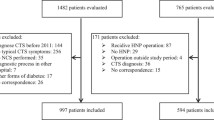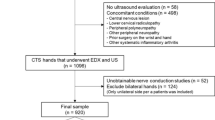Abstract
We aimed to evaluate the relation between the severity of carpal tunnel syndrome and metabolic syndrome. One hundred and fifty patients who had a clinical and electrophysiologically confirmed diagnosis of carpal tunnel syndrome (CTS), were included in this study. The patients were divided into two groups (with or without metabolic syndrome) according to the criteria of National Cholesterol Education Program. Eighty one (73.5 %) of the patients with CTS had metabolic syndrome. The patients with metabolic syndrome the severity of CTS was found 22.2 % had mild CTS, 56.8 % had moderate CTS, and 21 % had severe CTS. The patients without metabolic syndrome the severity of CTS was found 44.9 % had mild CTS, 40.6 % had moderate CTS, and 14.5 % had severe CTS. The severity of CTS between both groups was found to be statistically significant (p = 0.0009). While a correlation was found between the severity of CTS and high level of LDL with the presence of metabolic syndrome (correlation coefficient 0.209). In conclusion metabolic syndrome that appears to be a risk factor for CTS. At the same time, the presence of metabolic syndrome increases the severity of the disease.
Similar content being viewed by others
References
Boulton AJ, Malik RA, Arezzo JC, Sosenko JM (2004) Diabetic somatic neuropathies. Diabetes Care 27(6):1458–1486
Preston DC, Shapiro BE (2005) Electromyography and neuromuscular disorders. Clinical-electrophysiologic correlations. In: Preston DC, Shapiro BE (eds) Median neuropathy at the wrist, 2nd edn. Elsevier, Philadelphia, pp 255–281
Balcı K, Utku U (2007) Carpal tunnel syndrome and metabolic syndrome. Acta Neurol Scand 116:113–117
American Academy of Neurology (1993) Practice parameter for carpal tunnel syndrome. Report of Quality Standards Subcommittee of the American Academy of Neurology. Neurology 43:2406–2409
Grant RW, Meigs JB (2005) Management of the metabolic syndrome. Panminerva Med.üğ 47(4):219–228
Bloomgarden ZT (2003) American Association of Clinical Endocrinologists (AACE) consensus conference on the insulin resistance syndrome:25–26 August 2002, Washington, DC. Diabetes Care 26:1297–1303
Padua L, LoMonaco M, Gregori B, Valente EM, Padua R, Tonali P (1997) Neurophysiological classification and sensitivity in 500 carpal tunnel syndrome. Acta Neurol Scand 96(4):211–217
Bland JP (2007) Carpal tunnel syndrome. BMJ 335:343–346
De Krom MC, Knipschild PG, Kester AD, Thijs CT, Boekkooi PF, Spaans F (1992) Carpal tunnel syndrome: prevalence in the general population. J Clin Epidemiol 45(4):373–376
Lewis C, Mauffrey C, Newman S, Lambert A, Hull P (2010) Current concepts in carpal tunnel syndrome: a review of the literature. Eur J Orthop Surg Traumatol 20:445–452
MacDermid JC, Wessel J (2004) Clinical diagnosis of carpal tunnel syndrome: a systematic review. J Hand Ther 17(2):309–319
Kaymak B, Ozçakar L, Cetin A, Candan Cetin M, Akinci A, Hasçelik Z (2008) A comparison of the benefits of sonography and electrophysiologic measurements as predictors of symptom severity and functional status in patients with carpal tunnel syndrome. Arch Phys Med Rehabil 89(4):743–748
Deryani E, Aki S, Muslumanoglu L, Rozanes I (2003) MR imaging and electrophysiological evaluation in carpal tunnel syndrome. Yonsei Med J 44(1):27–32
Becker J, Nora DB, Gomes I, Stringari FF, Seitensus R, Panosso JS, Ehlers JC (2002) An evaluation of gender, obesity, age and diabetes mellitus as risk factors for carpal tunnel syndrome. Clin Neurophysiol 113(9):1429–1434
Hooper MM (2006) Tending to the musculoskeletal problems of obesity. Clevel Clin J Med 73(9):839–845
Nordstrom DL, Vierkant RA, DeStefano F, Layde PM (1997) Risk factors for carpal tunnel syndrome in a general population. Occup Environ Med 54(10):734–740
Werner RA, Albers JW, Franzblau A, Armstrong TJ (1994) The relationship between body mass index and the diagnosis of carpal tunnel syndrome. Muscle Nerve 17(6):632–636
Becker J, Nora DB, Gomes I, Stringari FF, Seitensus R, Panosso JS, Ehlers JC (2002) An evaluation of gender, obesity, age and diabetes mellitus as risk factors for carpal tunnel syndrome. Clin Neurophysiol 113(9):1429–1434
Oğuz A, Temizhan A, Abaci A, Kozan O, Erol C, Ongen Z, Celik S (2008) Obesity and abdominal obesity; an alarming challenge for cardio-metabolic risk in Turkish adults. Anadolu Kardiyol Derg 8(6):401–406
Geoghegan JM, Clark DI, Bainbridge LC, Smith C, Hubbard R (2004) Risk factors in carpal tunnel syndrome. J Hand Surg Br 29(4):315–320
Perkins BA, Olaleve D, Bril V (2002) Carpal tunnel syndrome in patients with diabetic polyneuropathy. Diabetes Care 25(3):565–569
Nakamichi K, Tachibana S (2005) Hypercholesterolemia as a risk factor for idiopathic carpal tunnel syndrome. Muscle Nerve 32(3):364–367
Satman I, Yılmaz T, Sengul A, Salman S, Salman F, Uygur S, Bastar I, Tütüncü Y, Sargın M, Dinççağ N, Karsidag K, Kalaça S, Özcan C, King H, the TURDEP Group (2002) Population-based study of diabetes and risk characteristics in Turkey: results of the Turkish diabetes epidemiology study (TURDEP). Diabetes Care 25:1551–1556
Freeland AE, Tucci MA, Barbieri RA, Angel MF, Nick TG (2002) Biochemical evaluation of serum and flexor tenosynovium in carpal tunnel syndrome. Microsurgery 22(8):378–385
Koh KK, Han SH, Quon MJ (2005) Inflammatory markers and the metabolic syndrome: insights from therapeutic interventions. J Am Coll Cardiol 46(11):1978–1985
Author information
Authors and Affiliations
Corresponding author
Rights and permissions
About this article
Cite this article
Önder, B., Yalçın, E., Selçuk, B. et al. Carpal tunnel syndrome and metabolic syndrome co-occurrence. Rheumatol Int 33, 583–586 (2013). https://doi.org/10.1007/s00296-012-2417-1
Received:
Accepted:
Published:
Issue Date:
DOI: https://doi.org/10.1007/s00296-012-2417-1




